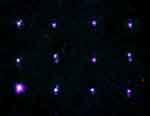Mazur Group
Plainly Speaking
Usually when light goes through a piece of glass, nothing happens to either the light nor the glass, i.e. the glass is transparent. With a powerfull femtosecond laser pulse, both the laser light and the glass can be changed. When we concentrate the laser light using a microscope lens, we produce a microscopic explosion inside the glass, which leaves behind a minuscule ball-shaped hole. We use microexplosions as a miniature "punch" to make patterns inside glass for such applications as high-density data storage. Microexplosions can also be used as a high-precision laser scalpel -- we have been able to eliminate a single cell in a skin sample, without affecting the neighboring cells!

In addition to patterning glass and cutting cells, we can also grow structures in three-dimensions. We use femtosecond laser pulses to grow polymers and metals on glass substrates for applications ranging from cell migration studies, to making engineered optical materials.